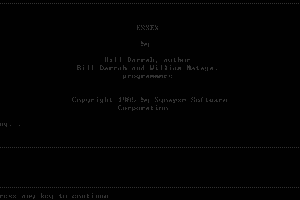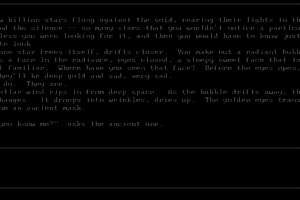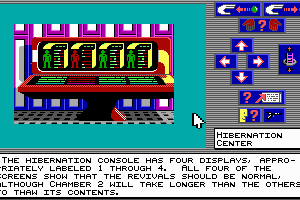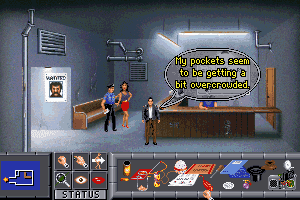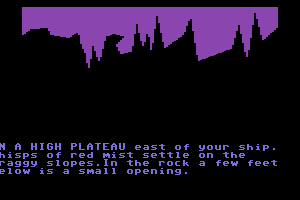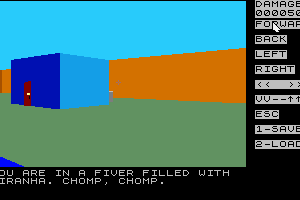Of Light and Darkness: The Prophecy
Windows - 1998
Description of Of Light and Darkness: The Prophecy
The end of the world is nigh...
Something tweaked inside me when I finally saw the controversial cover. Something smiled, and the name Of Light and Darkness had all the surreal fantasy to go along with the image of the beautiful contrasts of orange and blue painted upon an angel who hides her face rolling up into the fetal position. My husband said, 'gosh, that looks cool,' and I thought now this is a game I have to experience and as I discovered, it lives up to its mysterious, surreal and fantastic promises.
First off, it's important to distinguish Of Light and Darkness from any other adventure game. It's not your typical 'explore the world at a comfortable pace', nor is it of this world, although it was created out of the worries and frets people face at the end of each millennium. The inspiration for the game comes from the "end time" stories which gain in popularity as a millennium comes to a close and a new one begins. The struggle of good versus evil must be decided and if good prevails, then once more the struggle begins anew in the next millennium. It should be clarified that this game is not for the philosophically squeamish at heart. The story deals with issues that some of the more overly-sensitive 'moral majority' types might find offensive if they cannot see the humor in such things. The point is that Of Light and Darkness uses both imagery and people's fears in sophisticated tongue-in-cheek humor combined with intensive gameplay to present a fun, thought-provoking game which is well-rewarding if it is 'your cup of tea.'
That said, the story begins with your awakening. At first, you find yourself in a small radio station booth. This is the Game Booth, a room which provides all the selection options and where you can save, load and exit games. The DJ is a soft-spoken, overly cool, down-to-earth robot, named M.C Control, and plays rock music while offering his assistance. From here you can start a new game, continue a current game, play the same level, play a customized level or take the Free Tour option. Free Tour was one of the most useful and necessary options in the game and I will described this later. When you select to start a new game you are transferred to a studio room, Studio M'Fer, in which you awaken. Peering about, there are large stereo speakers on either side of a massive Jack in the Box which slowly bobs his head above you. A drum set in one corner and a couch and table behind you. The room lighting is dim, and on the table is something that warmed my heart. I am sure it's a generation thing, but there it was, bobbing its liquid red-plastic in oil: a lava-lamp, popular back in the rock era of the late 70's. As you look about you hear voices; they are the members of an invisible court, the MFer's, who speak about your fate. A female's voice presides, she is the judge, and you hear her call out the case of 'the People vs. Gar Hob - The Dark Lord of the Seventh Millennium.' You discover that it is you who had been selected as the 'Chosen One' and thrown into the battle between 'the forces of light and darkness' to rescue the world.
Biochemical weapons of mass destruction...
As the Chosen One, you must enter the village which rests somewhere between Heaven and Hell. The village is the rich creation of Gil Bruvel, whose art is sensuous, colorful and circus-like. The buildings in the village house the apocalyptic changes scheduled to destroy the earth as prophesied by Nostradamus, The Book of Revelations, and any number of sources. These are made-up of Pollution, Radiation, Flood, Plague, War, Earth Shifts and Poisoned Air. All the while, the Clock of Judgment is counting down to the coming of the end of the world, and it counts fast. The Clock is located in the center of the village and will be a useful tool. Hidden within the village are also the rooms representing the seven deadly sins, Accidie (Sloth), Anger, Avarice (Greed), Envy, Gluttony, Lust, and Pride. Your job will be to use these rooms to redeem apparitions (souls) of evil sinners who have existed over the millennia. Additional rooms are scattered about, and each has its purpose in either solving problems or redeeming souls. One in particular is the mask room.
Masks are the faces of the apparitions that float about the village, their purpose to place earthly artifacts related to their sin into the rooms of destruction. If they accomplish this, a colored light flashes through the village counting the clock down ever closer to the end. In the mask room are several colored stars which when clicked upon present to you a group of three masks. Each colored star represents three different apparitions and this gives you one clue to their redemption, for the color of the star tells you the color orb needed to redeem that apparition. For instance, if you click on the blue star and see three masks, one of them Caligula (as identified by the manual called the Book of the Damned), then a blue orb is required to redeem Caligula. Colored orbs are placed at random around the village and as long as you do not reload the game, they will reappear in the same positions after you have used them. To redeem Caligula then, you must discover which sin he committed during his life time, go to the room for that sin, have his artifact which you must gather from the room of destruction in which he places it and select both the artifact and blue orb in your inventory and use them by pressing the space bar while in the sin room.
If you have guessed correctly, Caligula is redeemed and again the MFer's voices are heard as the bailiff announces the redemption and the judge asks for Caligula's statement. 'So, what have you to say for yourself, Caligula?' This becomes hilarious as one after another, Ivan the Terrible, Cain, Xuanchiquel (Keeper of the Kukulcan's Temple) and others of equally historical or mythical nature are brought before the judges and offer their comments as to their actions. In addition, because this is a contest between the Chosen One and the evil Gar Hob, the poor soul must offer a few words to Gar, who is thoroughly disgusted with his apparitions.
This is a good point to mention that the list of sinners covers the history of recorded time, from all continents and walks of life. The actual acts of sin, such as a tyrant's murders of his own people to stay in power, or a suicide resulting in a lover's death, are mature topics in nature. They are only spoken about in clues, for instance a sword will tell of his owners ruthlessness, or a victim will comment on how they were wronged. The game is rated 13+ and to be honest, I agree with the rating within reason. The game deals with historical or mythical figures (I mean everyone should know Alexander the Great), and given the context of their sins and also actual abstract concept of sin itself, I think the game does require some parental guidance. If your child is well versed in reading literary works and has a mature concept of what the game is presenting then I would compare it to literary novels, such as the Scarlet Letter, which deals with several sins and uses light and darkness as its basic themes. There are some graphical images which may be a bit too much for some 14 year olds, such as the image in the room of Lust. However, remembering back to when I was 16, this game should be no problem at all for this age group, given the teen is not sensitive to certain issues from bad experiences.
Mommy, we can't drink the water anymore...
Discovering which sin an apparition has committed takes time, however you have clues. First of all the manual is of absolute necessity. It provides an introduction to yourself in journal style and also the thoughts of the Prophetess Angel who you will see often. In addition, the manual, or Book of the Damned, gives a small description of all 32 apparitions. This helps you guess which sin, based on the description, the apparitions may have committed. Also, if you take an artifact from a room of destruction, you may select the object in inventory and click on the Clock of Judgment to hear the victim of the sinner. Indeed the apparition will also give you a clue by clicking on his floating mask. Given that this is timed and you must gather information, it is quite difficult. And if you think you will learn a particular level and then restart it to go through it faster, think again, for each time the game is started the locations of the artifacts and the colors associated with the apparitions are scrambled. All that remains the same is the sin of an apparition and the artifact associated with it, and that is helpful. Also very useful are Trans-portals, small pyramid objects scattered about the village which can portal you to a specific room and are dropped at the location where they are used. So, if you would like to use it again, you must go back and pick it up where you last used it. These become increasingly more important as the game progresses until in the end they are absolutely vital.
As you progress through the redemption of souls, at certain locations within the village a viewing screen will appear and upon it, you will see a vision of the Prophetess Angel. She, like Mary Magdalena, was also a sinner. Angel Gemini was an exotic dancer in Las Vegas renowned for her beauty who was overcome with a prophecy on stage of the coming battle between light and darkness. Seeing the light, she chose to change her sinful life by leaving the stage. At her final show, she announced another prophesy, that of her own death, the struggle of the Dark Lord of the Seventh Millennium to use her body as the Vessel of Resolution and that she had murdered her lover and advisor who revealed to her he was the Heart of Darkness. At that moment she was shot and believed by her followers to have entered into a trance, the return from which would require her to be resolved in the Village of the Seven Catastrophes. Her fate is intertwined with yours and Gar Hob's and you see her sitting in a chair flanked by dark blue dolphins speaking to the Evil One. With each vision of yours, her story and her relationship to you as the Chosen One is revealed slowly in snippets and pieces. Eventually, if you are successful, the game will bring all three of you to the final confrontation.
El Nino warms the waters...
Just after I had completed the first level, I thought well, this was a bit too easy. Although I had completed the task, I was again brought to the village, only some new areas previously restricted were available and some doors required certain artifacts to unlock them. Hmm...gameplay seems the same and even some of the apparitions I had already redeemed were loose and running around. The explanation was that the first round was not enough to decide the fate of the Millennium, and by releasing the apparitions Gar gets another chance. This is true for level three as well, where he is allowed to do his worst and lets loose three Dark Lords, who are hard to beat. As I worked on level two, the game-play had changed, it was like a puzzle sorting out how to find the right objects to unlock doors behind doors all the while keeping ahead of the Clock. You see, if you have an artifact the apparition will come for you and attempt to get it back blocking your way or worse in the case of Dark Lords.
Level three, I have to say, is the best. Here Caligula, Carlos Marcello (a 1930's gangster), Marie Antoinette and Shakem Ben-Jamin have special abilities to thwart you, teleporting you away from your desired location at the wrong moment if you have one of their artifacts, and these you need to unlock doors. The game-play just intensifies with each level in just the right amount of difficulty to keep you glued to the screen and feeling confident enough that you learned well in the previous level to attempt the next, but is intense enough to stretch you to the barely making it point. The Dark Lords will do even more evil things to you if they catch you with their artifacts, which are skulls with different colored eyes. They can steal from your inventory, or paralyze you with curses which you must cure and if the room you need to visit is locked, then the game is over, since you cannot use your inventory while paralyzed.
One of the nice aspects is that there are no breaks within a level to change CDs. The game comes on three separate CDs and the only changes necessary are when you begin the next level. This is usually the time you need a break and are happy to make a switch and take a breather before attempting the next level. I used pencil and paper to keep track of things, with lists of colors and the masks associated with them within a level, then the artifacts related to each mask (which also doesn't change), and the apparitions' sins. This way when I had an artifact I knew easily which room and which color orb was necessary to quickly redeem the soul.
Free Tour was always useful. By selecting this option after completing a level you can take a tour of the village and explore the new areas added. When you click on locked rooms, it will tell you which artifact is necessary to open the door, adding another piece of information to your list. Also, a free key is provided to look at all the rooms even if they are locked. No apparitions are there, and the mask room doesn't work in Free Tour so you cannot do prior research on the colors before actually starting the level. This way I could plan where the rooms were, and what I needed to get there, then start the level. One note, just because trans-portals and orbs are there in the Free Tour does not mean they will be in the same position when you start the level.
Is that a baby's cry?
Of Light and Darkness has a very simple interface which is mostly point and click with the mouse when the cursor changes to a pair of harlequin shoes for walking, or a grasping hand for grabbing. To use items in the inventory you must right click on the mouse and while holding down the right mouse button, select with the left mouse button the item to highlight. After selection, you may release the mouse buttons and then press the space-bar. There are only three object types, portals, orbs and artifacts which will appear in inventory once grasped. This seems fairly simple, almost too simple, however when traveling from one location to the other it is quick and efficient and actually faster than having to rotate through your inventory which gets quite large at times using keys. I was tremendously thankful for the easy interface due to a recent accident I had with a cooking knife which gave me several stitches in my left middle-finger. Despite the injury I had no problem whatsoever playing the game.
The only annoying thing was having to exit the village to save the game. To save one must hit the escape key and return to the Game Booth, click the save game button and select a slot to save in. This was time consuming, and in today's advanced options it would have been nice to just hit a hot-key and give the file a name or such. It did not detract from the game however, since the surreal place you require help from is the Game Booth. They do have hot keys for adjusting the gamma brightness, size of images, rotations of moving objects, and to capture pictures or enter passwords. Passwords can be obtained for special objects (cheats) present in the game by going to the Of Light and Darkness web-site and solving four puzzles online. The puzzles are word-scrambles which are fun and relate to the game and are not too hard to solve. Although I tested out the puzzles I did not use the cheats in order to see if the game can be completed and my experience is that they are not necessary as I was able to get through without them.
Movement through the game has flow. Each time you click there is animated movement to the next location which gives you the feeling of flying or riding a roller-coaster. There is no break between the point you are at and the next, rather there is perspective movement, so it is not a Myst clone. You also have 360 degree free rotation and can, at times, look up or down in certain locations. I had to be careful since each time I worked on a level I did it in one go. Well, except for hitting the pause button to take a break, but leave the game running. This gave me some motion dizziness, so take breaks more often then me. I would say I would work two hours at a stretch before breaking.
The graphics were done by Tribal Dreams, a group of SGI graphics artists associated with Interplay using the SGI 3Di engine. They do not support hardware acceleration, and it is not necessary for this game which still looks sumptuous to the eye, setting off all of Gil Bruvel's world excellently. Angel is a 3D model created with Lightwave, and Motion Capture was used to give her life-like expressions. There are arguments for and against Motion Capture, however it did not deter from the game and enhanced it tremendously in this case, bringing forward the story and giving you the chance to try and read her thoughts. Since she goes through the temptations of the seven sins, it's fascinating to watch.
The sense of immersion is enhanced by the sounds ever-present whether in the Game Booth, MFer's Studio or the village. It changes as you move from location to location, soft voices crying about the changes in the world, expressing sadness, fear and emotion. Several songs in the game where performed by the Millennium Fake brothers (MFer's) and fit the 'scene' perfectly. Each room of destruction or sin has its own music and theme of wafting voices. Some are comic, others are downright scary, and others thoroughly aggravating. As you walk through the outside area of the village around the clock, the sounds blend and mix, and sound affects add to the sensations, a rotating door that swishes as if breathing, the crackling static of irradiation, the exhaust explosions of a pump-engine. While in Free Tour there is a lady announcer who will tell you things you need to know, as well as in the different rooms where you may see the cursor change to a rotating gramophone, on which you may click to hear additional information. She definitely was one of the most irritating aspects of the game, but then again, aren't all information announcement systems irritating? 'Attention, you have one minute to return an apparition to the Dark Isle.' Horribly grating.
This is the end....
The Dark Isle is where Gar Hob resides and has the Angel captive. You must reach there to win the game and pass two pyramid puzzles at the end of levels two and three. All the clues you need are within the game, and I won't spoil the fun by giving away any secrets. If you really get stuck, Games Domain does offer a walkthrough. Gar is quite hideous, and if you beat him, the Seventh Millennium is saved and you are treated to an animation of resolution. This then resets things for the next Millennium where another Dark Lord, like Gar, is chosen by the MFer's to rule the Eighth Millennium. I think for me, it was well worth the last scene which sent me in stitches laughing to my husband, who agreed with the choice wholeheartedly. This game is creative, humorous, fast-paced, intense, intellectual and unique with elements of music, sounds, dialog and images that mix together to form an eclectic creation. The game-play may seem simple at first, but builds in layers. Remember, it is not something for the ultra sensitive, but I have to say hats off to Interplay for this one.
Review By GamesDomain
External links
Captures and Snapshots
Comments and reviews
There is no comment nor review for this game at the moment.
Write a comment
Share your gamer memories, give useful links or comment anything you'd like. This game is no longer abandonware, we won't put it back online.
Buy Of Light and Darkness: The Prophecy
Of Light and Darkness: The Prophecy is available for a small price on the following websites, and is no longer abandonware. GOG.com provides the best release and does not include DRM, please buy from them! You can read our online store guide.
Game Extras and Resources
Some of these file may not be included in the game stores. For Of Light and Darkness: The Prophecy, we have the following files:
Similar games
Fellow retro gamers also downloaded these games:
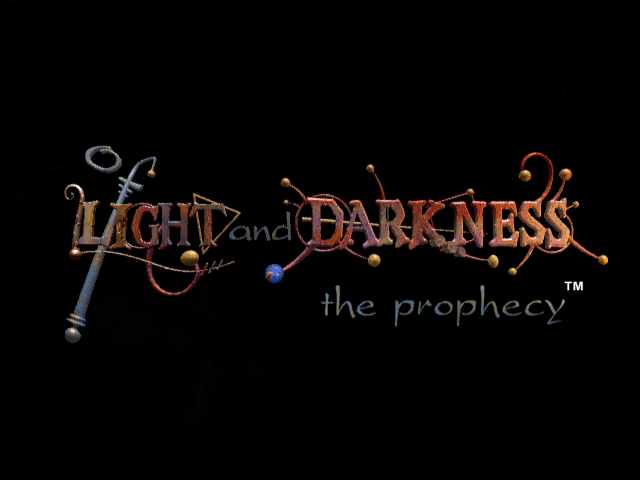

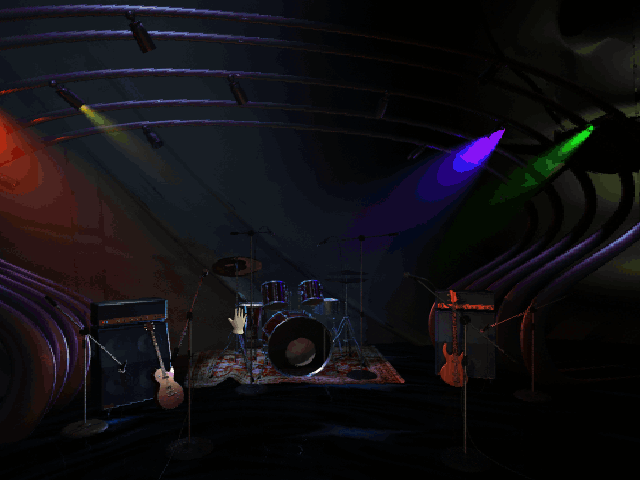
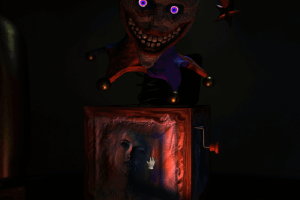
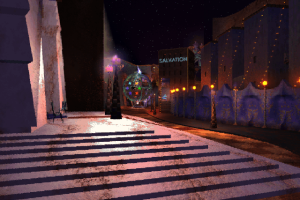
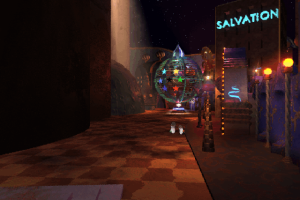
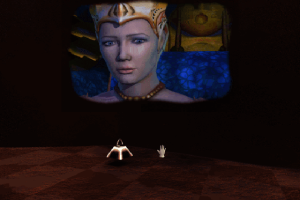
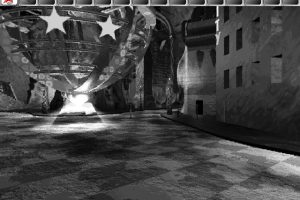
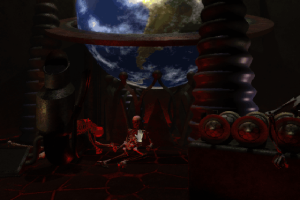

 28 MB (Windows)
28 MB (Windows)